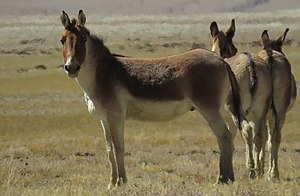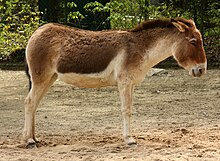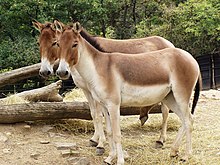Kiang
| Kiang | ||||||||||||
|---|---|---|---|---|---|---|---|---|---|---|---|---|

Wild kiangs in the Changthang nature reserve |
||||||||||||
| Systematics | ||||||||||||
|
||||||||||||
| Scientific name | ||||||||||||
| Equus kiang | ||||||||||||
| Moorcroft , 1841 |
The kiang or Tibetan wild ass ( Equus kiang ) is a species of mammal from the horse family ( Equidae ). He lives in Tibet and neighboring regions, where he lives in steppe-like open landscapes and feeds mainly on grasses. The Asiatic donkey is considered to be its closest relative , although the kiang is larger and more "equine" than this.
features
Habitus
The Kiang represents the largest representative of the wild donkey and reaches a head-trunk length of 182 to 214 cm (plus a 32 to 45 cm long tail), a shoulder height of 132 to 142 cm and a weight of 250 to 400 kg. Female animals with a weight of 250 to 300 kg are on average smaller. In general, it is characterized by a large head and, compared to the Asian donkey ( Equus hemionus ), a narrower and shorter trunk, the limbs are very long. Other differences are the shorter ears, the longer mane with hair up to 18 cm long, and the wider hooves, which are similar to those of the wild horse ( Equus ferus ). The top of the fur is light red in color in summer, the long, dense winter fur is more brownish. The hair of the winter coat reaches 35 to 46 mm in length and is therefore more than twice as long as that of the summer coat. On the back they have a striking black stripe (eel line), which is up to 75 mm wide in winter and only up to 65 mm wide in summer. The underside is white, although the white coloring can extend to the stripe on the back in some places. As a rule, however, it is crescent-shaped on the flanks from the darker top. The legs, throat and muzzle can also be colored white. The front part of the snout is sometimes colored brown. The ears, which are up to 22 cm long, are also characteristic.
Skull and dentition features
The skull is between 47 and 54 cm long, with the snout itself being relatively short and compact. The height of the skull is 9.4 cm. The occiput is arched inwards (concave) in side view and has a strong bulge. The nasal bone is weak in shape, but grows up to 22 cm in length. The inside of the nose extends far back. The approximately 38 cm long lower jaw is solidly built with high joint ends. The dental formula for adult animals is: . The incisors correspond to those of the other horse species, but are clearly perpendicular in the jawbone compared to those of the Asiatic donkey. The canine can, but does not have to be, trained. A diastema of up to 9 cm in length gapes between the front and rear teeth . The premolars and molars have a relatively similar structure with high tooth crowns ( hypsodont ) and strongly twisted enamel folds on the chewing surface as well as a pronounced proportion of tooth cement . The course of the posterior enamel folds on the lower molars is striking, some of which are more rounded between two distinct protrusions ( metaconid and metastylid ) than in other donkey species and thus resemble the wild horse, which has a U-shaped inflection there. However, this characteristic is variable within the Kiang.
Vocalizations
Several communication sounds are known to the Kiang. Aggressive animals make grunting and whistling noises. Alarmed animals use an emitted snort, while contact calls represent a high-pitched whistle. The typical sounds known from wild horses and Asiatic donkeys have not yet been observed.
distribution and habitat
The Kiang endemically inhabits the entire highlands of Tibet , a system of mountains and plateaus north of the Himalayas . The spread to the south is restricted by the Himalayas and to the north by the Kunlun and Arjin Shan mountain ranges . The largest populations are in the Tibet Autonomous Region and in the neighboring Chinese provinces of Qinghai and Sichuan , which also form the easternmost distribution limit. They also occur in northern India ( Ladakh , Sikkim ) and Nepal . The western limit of the habitat is reached in the Khunjerab National Park in Pakistan . The habitats of the Kiang are dry and winter-cold grasslands, steppes and semi-deserts from 2,700 to over 5,500 m above sea level. These landscapes consist largely of feather grass steppes with only a small proportion of bushes. The population density is low and is given between 0.03 and 0.86 individuals per km², but in individual areas up to four animals can stay on one square kilometer.
Way of life
Territorial behavior
The kiang is one of the less territorial representatives of today's horses, but is largely a solitary animal. In some cases, however, there are groups of seven to eleven individuals on average, made up of mares with their foals and young animals of both sexes, but the greatest bonding force exists between the mother and the newborn foal. Occasionally, large herds of up to 500 animals can be observed, but they are hardly stable. Male animals are predominantly solitary and territorial, with the boundaries and paths of the territories up to 5 km² in size being marked with excrement and urine . The districts contain feeding and resting places that are several hundred meters apart. The territories are often defended against intruders with bites and kicks, aggressive animals show an upright posture of the head with back ears and a horizontal tail. Mares with foals are also driven out of the territories. The territories are not kept continuous, however, sometimes the males join together to form bachelor groups in winter.
As a predominantly diurnal animal, the Kiang undertakes extensive migrations in search of food, some of which are tied to the seasons but do not follow a cycle. In summer the groups often move to higher and more hilly areas, in autumn and winter, on the other hand, they prefer flat areas. Day hikes are also known, which also lead to higher habitats at lunchtime. As a good swimmer, the Kiang is able to cross rivers and other bodies of water.
nutrition
Like all horses, the kiang is a herbivore that feeds primarily on grasses and other soil-growing plants. The kiang is adapted to the hard, silicic acid-containing grasses with its high-crowned and cement-rich molars. The most commonly used food crops are sweet and feather grasses , which alone make up 65% of all ingested plants. Furthermore, even sour grasses and sedges , as well as couch grass consumed. Especially in winter, when there is only little grass available, the kiang does not disdain the roots of the pointed keels . Only rarely, however, are softer parts of the bushes taken up. During times of abundance of food (July and August) they can gain up to 45 kilograms.
Little is known about the water consumption of the Kiang. Streams and lakes are the main resources available, but most of them are iced over in winter. It is possible that the donkey species largely regulates its water needs through vegetation and snow, as is also known from other ungulates in Tibet.
Reproduction

A Kiang is sexually mature at three to four years of age. In July and August the males begin to follow the mare groups, they fight with each other for the mating privilege and also try to drive other males from "their" herd. Stallions woo mares by running after them, typical is a bowed head with lying ears. The mating season ends in mid-September.
After a gestation period of almost one year (ten to twelve months), the mare usually gives birth to a single young in July or August. This is around 90 cm high and weighs around 36 kg. Newborn kiangs flee the nest , they can follow their mother within hours. At around one year old, they are self-employed, but the development process of a young animal has so far been little studied. Only a short time after birth, the mother animal is ready to receive again, which can sometimes lead to the killing of a young animal by a stallion. The maximum age of an animal is 20 years in the wild, in captivity it was up to 26 years.
Interaction with other animal species
The wolf , especially the Tibetan wolf and the snow leopard, come into question as predators, but they can usually only prey on young animals or decrepit individuals. Other predators have little influence on the population. Investigations into the remains of brown bears revealed no evidence that the kiang belongs to its prey spectrum. In the distribution area, the donkey lives sympathetically with the Tibetan gazelle , the Tibetan antelope , the blue sheep and other ungulates . But there is also overlap with domesticated herbivores.
Parasites
Little is known about diseases and parasite infestations in the kiang. The horse palisade worm and roundworms have been described as endoparasites . Newborn babies may develop omphalitis . Evidence of infections caused by Mycobacterium is also very rare .
Systematics
|
Internal systematics of the genus Equus according to Jónsson et al. 2014
|
The Kiang is a member of the Equus genus , today's modern horses. Due to the morphology of the lower molars, it belongs to the group of stenonine or non-caballine horses. Sometimes the kiang is considered a subspecies of the Asiatic donkey . However, several DNA analyzes have suggested that the Kiang is a separate species that is very closely related to the Asian donkey. Both, together with the also related but extinct European wild ass ( Equus hydruntinus ), are also partially assigned to the subgenus Hemionus , the name of which is derived from the scientific name of the Asian donkey Equus hemionus . Genetic studies from 2017, however, give rise to the assumption that all three forms (kiang, Asian donkey and European wild donkey) represent a single species. In this study, the kiang shows a stronger connection to the jiggetai, the Mongolian subspecies of the Asian donkey. According to the authors, the kiang could therefore be understood as a form of the Asian donkey adapted to high mountain conditions. The possibly closest related horse species to the Kiang and the Asian donkey are the African donkey and the various zebras.
A distinction is made between three subspecies, the status of which is, however, partly doubtful:
- E. k. holdereri Matschie , 1911; eastern distribution area
- E. k. kiang Moorcroft , 1841; western distribution area
- E. k. polyodon Hodgson , 1847; southern distribution area
Kiang fossil finds are relatively rare. There are similarities to Equus conversidens , which became extinct in the Pleistocene, as well as to Equus sivalensis, which was documented in India and Pakistan during the transition from the Plio to the Pleistocene . These correspondences mainly concern the size, proportions of the limbs and the morphology of the teeth.
Threat and protection

Compared to other wild asses, Kiangs are not threatened. Originally they were hunted by Tibetan nomads for food or for religious reasons, but this was not done systematically. It was not until the Chinese invaded Tibet in 1950 that the stocks fell drastically. Since the end of the 20th century, strict protective measures against poaching and the creation of a protected area network of up to 600,000 km², especially in the Changthang highland steppes, have led to the stabilization and recovery of stocks. There are around 68,500 Kiangs in China, 48,000 of them in Tibet. This represents about 90% of the total population. Another 2000 live in India. There are contradicting reports about the occurrence of Kiangs in Pakistan, Nepal and Bhutan, the populations there possibly comprise only a few dozen individuals. The total population is estimated at 70,000 animals; However, there are also assumptions of up to 200,000, but these are rejected as unrealistic. The IUCN lists the Kiang as a Least Concern (“not endangered”). Local threats lie in the population increase and the associated conflicts with rural settlers and their livestock, but also in the increasing development of the landscape through mining .
In 2008 around 114 animals were kept in zoos around the world, all of them of the subspecies E. k. holdereri belonged to. Despite numerous attempts to domesticate the kiang over the past 150 years, this has not yet been successful.
etymology
The term "kiang" comes from Tibetan , but the exact meaning is unclear. In the Indian province of Ladakh the animal is called "skiang", while the Chinese name is "zang yelu".
literature
- Ernest P. Walker (greeting), Ronald M. Nowak (arr.): Walker's Mammals of the World . Johns Hopkins University Press, Baltimore 1999, ISBN 0-8018-5789-9 .
Individual evidence
- ↑ a b N. V. Paklina and C. van Orden: Numbers, distribution and social structure of Kiang (Equus kiang Moorcroft 1841) population in the Southwestern Part of Tibet, China. Exploration of the biological resources of Mongolia 10, 2007, pp. 213-218
- ↑ a b c d e f g h i j k l m n o p q Antoine St-Louis and Steeve D. Côté: Equus kiang (Perissodactyla: Equidae). Mammalian Species 835, 2009, pp. 1-11
- ↑ Ingmar M Braun and Wolfgang Zessin: Horse representations in paleolithic wall art and the attempt at their zoological-ethological interpretation. Ursus, Mitteilungsblatt des Zooverein and Zoo Schwerin 17 (1), 2011, pp. 4–26
- ^ A b c Colin Peter Groves and V. Mazák: On some taxonomic problems of Asiatic wild asses; with the description of a new subspecies (Perissodactyla; Equidae). Journal for Mammalian Science 32, 1967, pp. 321-355
- ↑ N. Spasskaya: Investigation of the Kiang (Equus kiang, Equidae) skull from Ladakh, India. Exploring the biological resources of Mongolia 10, 2007, pp. 227–230
- ↑ a b Benktesh Dash Sharma, Jan Clevers, Reitze De Graaf, and Nawa Raj Chapagain: Mapping Equus kiang (Tibetan Wild Ass) Habitat in Surkhang, Upper Mustang, Nepal. Mountain Research and Development 24 (2), 2004, pp. 149-156
- ↑ NV Paklina and C. van Order: Kiangs (Equus Kiang, Moorcroft 1841) in Sikkim, India. Exploring the biological resources of Mongolia 10, 2007, pp. 201-203
- ^ A b Nita Shah: Status and Action Plan for the Kiang (Equus kiang) In: PD Moehlman (Ed.): Equids: Zebras, Asses, and Horses: Status Survey and Conservation Action Plan. IUCN / SCC Equid Specialist Group, IUCN (The World Conservation Union). Gland (Switzerland) and Cambridge, 2002, pp. 72–81
- ^ A b N. Shah, A. St. Louis, Z. Huibin, W. Bleisch, J. van Gruissen and Q. Qureshi: Equus kiang . In: IUCN Red List of Threatened Species. Version 2012.2, last accessed February 24, 2013.
- ↑ NV Paklina and C. Van Orden: territorial behavior of Kiang (Equus kiang Moorcroft 1841) in Ladakh (India). Exploration of the biological resources of Mongolia 10, 2007, pp. 205–211
- ↑ Xu Aichun, Jiang Zhigang, Li Chunwang, Guo Jixun, Wu Guosheng and Cai Ping: Summer food habits of brown bears in Kekexili Nature Reserve, Qinghai – Tibetan plateau, China. Ursus 17 (2), 2006, pp. 132-137
- ↑ MP Dagleish, K. Stevenson, G. Foster, J. McLuckie, M. Sellar, J. Harley, J. Evans and A. Brownlow: Mycobacterium avium subsp. hominissuis Infection in a Captive-Bred Kiang (Equus kiang). Journal of Comparative Pathology 146 (4), 2012, pp. 372-377
- ↑ a b Hákon Jónsson, Mikkel Schubert, Andaine Seguin-Orlando, Aurélien Ginolhac, Lillian Petersen, Matteo Fumagallic, Anders Albrechtsen, Bent Petersen, Thorfinn S. Korneliussen, Julia T. Vilstrup, Teri Lear, Jennifer Leigh Myka, Judith Lundquist, Donald C. Miller, Ahmed H. Alfarhan, Saleh A. Alquraishi, Khaled AS Al-Rasheid, Julia Stagegaard, Günter Strauss, Mads Frost Bertelsen, Thomas Sicherheitsitz-Ponten, Douglas F. Antczak, Ernest Bailey, Rasmus Nielsen, Eske Willerslev and Ludovic Orlando: Speciation with gene flow in equids despite extensive chromosomal plasticity. PNAS 111 (52), 2014, pp. 18655-18660
- ↑ Ann Forstén: Mitochondrial DNA time-table and the evolution of Equus: comparison of molecular and paleontological evidence. Annales Zoologici Fennici 28, 1992, pp. 301-309
- ↑ Wolfgang Zessin, Elke Gröning and Carsten Brauckmann: Comments on the systematics of recent Equidae (Mammalia). Ursus, Mitteilungsblatt des Zooverein und des Zoo Schwerin 15 (1), 2009, pp. 20–31
- Jump up ↑ a b Ludovic Orlando, Jessica L. Metcalf, Maria T. Alberdi, Miguel Telles-Antunes, Dominique Bonjean, Marcel Otte, Fabiana Martin, Véra Eisenmann, Marjan Mashkour, Flavia Morello, Jose L. Prado, Rodolfo Salas-Gismondi, Bruce J. Shockey, Patrick J. Wrinn, Sergei K. Vasil'ev, Nikolai D. Ovodov, Michael I. Cherry Blair Hopwood, Dean Male, Jeremy J. Austin, Catherine Hänni and Alan Cooper: Revising the recent evolutionary history of equids using ancient DNA. PNAS 106, 2009, pp. 21754-21759
- ↑ a b Samantha A. Price and Olaf RP Bininda-Emonds: A comprehensive phylogeny of extant horses, rhinos and tapirs (Perissodactyla) through data combination. Zoosystematics and Evolution 85 (2), 2009, pp. 277-292
- ↑ E. Andrew Bennett, Sophie Champlot, Joris Peters, Benjamin S. Arbuckle, Silvia Guimaraes, Mélanie Pruvost, Shirli Bar-David, Simon JM Davis, Mathieu Gautier, Petra Kaczensky, Ralph Kuehn, Marjan Mashkour, Arturo Morales-Muñiz, Erich Pucher, Jean-François Tournepiche, Hans Peter Uerpmann, Adrian Bălăşescu, Mietje Germonpré, Can Y. Gündem, Mahmoud-Reza Hemami, Pierre-Elie Moullé, Aliye Ötzan, Margarete Uerpmann, Chris Walzer, Thierry Grange and Eva-Maria Geigl: Taming the late Quaternary phylogeography of the Eurasiatic wild ass through ancient and modern DNA. PLoS ONE 12 (4), 2017, p. E0174216, doi: 10.1371 / journal.pone.0174216
Web links
- Equus Kiang in the Red List of Threatened Species of the IUCN 2012. Posted by: N. Shah and others, 2008. Accessed February 24, 2013.
- More information, photos and distribution map



